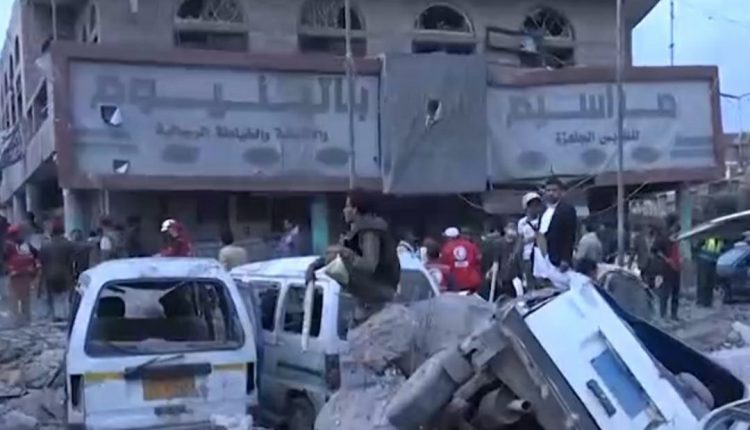Israeli airstrikes on Sanaa: A military failure exposes Israeli occupation’s fear of Yemen’s voice and power
SANAA, Sept. 11 (YPA) – In a growing climate of military and political escalation, the Israeli occupation forces have embarked on a dangerous military gamble by targeting the headquarters of the Sanaa military spokesperson, Brigadier General Yahya Sarie.
This was an attempt to silence a voice that the occupation authorities believe has tipped the balance of power in the region. However, Sanaa’s response preceded the strike and was devastating. It announced the launch of a sophisticated hypersonic, multi-warhead “Palestine 2” missile that shook occupied Quds (Jerusalem), while Yemeni drones struck Ramon Airport and two other targets in Eilat. Sanaa forces have confirmed that “what’s coming is greater.”
The response did not stop there. Israeli media outlets admitted that Yemeni surface-to-air missiles forced Israeli aerial formations to retreat, while Israeli intelligence revealed the threat of targeting oil facilities in Haifa, Ashkelon, and Eilat. This escalation prompted the Israeli Chief of Staff, Eyal Zamir, to publicly admit that the balance of power in the Middle East is shifting.
The failure of the strikes and their ramifications
The recent strikes, including the targeting of the heart of Sanaa, the government complex in Jawf, and media facilities, are described as “militarily failed strikes.” This is because targeting these locations, which are often publicly known, yields little practical result. It does not stop the launch of Yemeni missiles and drones, nor does it prevent continued support for Gaza. On the contrary, the coming hours may witness Yemeni operations targeting the Israeli depth, as has happened in the past with repeated and effective operations, such as the closure of Ramon Airport.
It is believed that the Israeli focus on civilian infrastructure and economic facilities aims to pressure Yemeni public opinion and the average citizen. However, this approach ignores the “psychology of the Yemeni people” who view these attacks as a response to their pro-Gaza stance. These strikes may even increase Yemeni “pride” and push them toward more support for the leadership and the army in their ongoing solidarity with Gaza and targeting of the Israeli depth.
Media targeting and propaganda
Reports indicate casualties among journalists from the Israeli aggression on the “Moral Guidance Department” headquarters in the Al-Tahrir district in central Sanaa. Targeting this site raises questions about the nature of the target. Experts believe that the targeting of the Al- Yaman and 26 September newspapers’ buildings, located in a densely populated area, is a form of “targeting historical and media facilities.” This building is said to be about 100 years old and has an old historical character.
Brigadier General Abdul Ghani Al-Zubaidi, a military and strategic expert in the Sanaa forces, confirmed that the Israeli targeting of the Moral Guidance Department headquarters in central Sanaa, which resulted in casualties, is part of a context in which the Israeli occupation seeks a “victory image” to market to its internal audience.
Al-Zubaidi explained that the headquarters is not a strategic or hidden military target; rather, it is a well-known and open department located in a densely populated area with shops. He indicated that this targeting points to “military stupidity” on the part of the occupation, affirming that “these strikes will not stop the launch of Yemeni missiles and drones and will not deter Yemen from its continued support for Gaza.”
In response to the Israeli military’s statement justifying the attack as targeting the “military media department responsible for disseminating incitement and propaganda messages,” Brigadier General Al-Zubaidi described it as “a form of misleading and exaggerated propaganda.” He stressed that the building, which dates back nearly 100 years, is a media headquarters from which local newspapers are issued and where journalists work. It has no sensitive military nature. He added that targeting this headquarters is an attack on a “historical facility,” considering it a well-known place and that targeting the heart of a densely populated capital is an act of “cowardice and triviality.”
Widespread condemnation of the attack
Local, regional, and Islamic media circles have condemned in the strongest terms the Israeli aggression that targeted the 26 September and Al-Yaman newspapers in the Republic of Yemen, resulting in the martyrdom and injury of several journalists, with some still missing under the rubble.
Media outlets in separate statements affirmed that the targeting of media institutions and journalists comes in the context of attempts to silence the voice of truth and deprive peoples of their legitimate right to access information and document crimes and violations.
They considered the continuous targeting of media institutions and journalists as a major responsibility for the international community, which champions freedom and human rights, especially with the continuation of Israeli attacks without any accountability.
The statements pointed out that anyone who justifies or covers the aggression against journalists and media institutions bears full responsibility and is considered a partner in the crime. They praised the role of the Yemeni media, which, despite all the difficulties and sacrifices, has proven its effectiveness in highlighting the resilience and steadfastness of the Yemeni people in the face of aggressions and making a prominent contribution to raising the voice in support of justice and exposing crimes, which is what the enemy entity is trying to target to hide the truth.
Media circles clarified that the protection of journalists and media institutions is a guaranteed right in international conventions and agreements, particularly the Geneva Conventions, the International Covenant on Civil and Political Rights, and relevant Security Council resolutions, making the Israeli aggression a blatant violation of international law and a flagrant assault on media freedom.
A security plan imposed by the battle
In response to a question about whether Brigadier General Yahya Sarie, the head of the Moral Guidance Department, records his speeches at the targeted headquarters, Brigadier General Al-Zubaidi confirmed that Brigadier General Sarie has not been there since the start of the “Al-Aqsa Flood” battle, pointing out that there is a “known security plan” for dealing with the enemy.
Therefore, the Israeli occupation did not achieve any success in its targeting, thus refuting any attempt by the occupation to market the targeting of the department’s director. He added that targeting an exposed and well-known department is “targeting open areas that do not have a sensitive dimension with regard to the military aspect.”
A complex scene and an unknown future
Experts attribute the Israeli occupation’s ability to carry out such attacks with impunity to the “savage Western support” for this entity, in addition to the “dithering and fragmented Arab position.”
When there is no serious and clear stance from Arab countries on this issue, the Israeli entity will continue its aggressions. Experts point out that the savagery is not limited to military attacks but extends to suppressing demonstrations supporting the Palestinian cause in Western countries.
In light of these developments, observers believe that the Middle East is being reshaped by fire and blood, and that rising powers from Sanaa to Gaza, and from Damascus to Moscow, are declaring that the era of American and occupation dominance is approaching its end.
This complex scene exposes the falsehood of the occupation’s claims and confirms that the balance has shifted and that what is coming will be greater and more impactful.
YPA®


